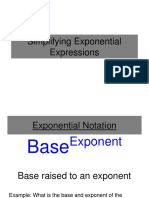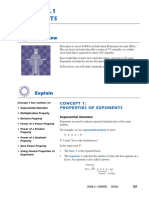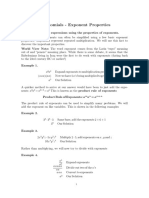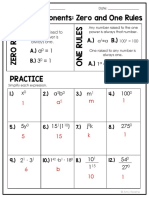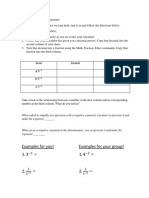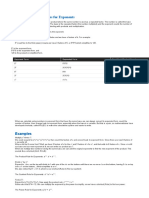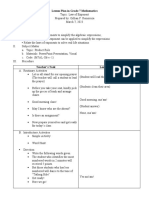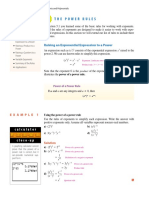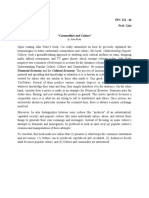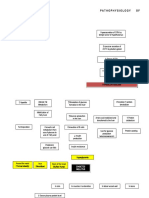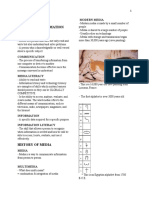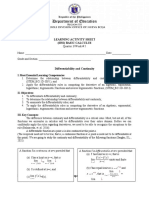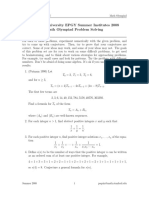Simplifying Expressions with Exponents
Learning Objective(s)
Simplify algebraic expressions with exponents.
Introduction
Exponents can be attached to variables as well as numbers. When they are, the basic rules
of exponents and exponential notationapply when writing and simplifying algebraic expressions that contain
exponents.
Simple Rules of Exponents
Let’s look at some of the basic rules of exponents.
Any number or variable raised to a power of one is simply that number. In return, any number or variable that
doesn’t have an exponent shown with it can be considered to have an exponent of 1. Below are some
examples:
51 = 5 18 = 181 x1 = x xy = x1y1
Another rule of exponents is that any non-zero number or variable raised to a power of 0 equals 1. = 1 for
x ≠ 0.
Simplify the expression
A) 0
B)
C)
D)
Show/Hide Answer
A) Incorrect. , not 0. The correct answer is C) .
B) Incorrect. , not x. The correct answer is C) .
C) Correct. and
D) Incorrect. can be written more simply as y. The correct answer is C) .
As with numbers, variables raised to a negative power are equivalent to 1 over the variable to the same but
positive power. For example:
�
Exponent of 0 or 1 and Negative Exponents
Any number or variable raised to a power of 1 is the number itself.
Any non-zero number or variable raised to a power of 0 is equal to 1.
Any non-zero number n and any integer x, . For example,
Notice that these rules say that the base, n, must be a “nonzero number”. When n is 0, both n0 and n raised to
a negative power are undefined.
Let’s take a look at how to simplify an algebraic expression with negative exponents in the numerator and the
denominator. It’s helpful, especially at first to separate the variables and simplify them individually:
Example
Problem
Simplify
Rewrite as a product of
fractions
Rewrite variables with
negative powers following
the rule for negative
exponents:
Simplify division by a fraction
Multiply fractions
Answer
�
Products and Quotients of Powers
Now that we’ve seen how to simplify variables with exponents, let’s learn how to multiply and divide them.
We’ll start with finding the product of two exponential terms with the same base. To find the product of
powers with the same base, just add the exponents and keep the base the same. Consider the example
. We could rewrite this problem as follows:
= = =
Or we could just add the exponents:
= =
That second method is a lot easier.
Division with exponential notation has a similar short cut. To find the quotient of powers that have the same
base, subtract the exponents. Here’s how it works:
Example
Problem
Simplify
Rewrite exponential notation
Rewrite as product of fractions
Use associative property to regroup
factors
Because
Product of powers
Answer
Here are a few additional examples:
�
Rules for Multiplying and Dividing with Exponents
When multiplying two terms with the same base, add the exponents:
When dividing two terms with the same base, subtract the exponent in the denominator from the exponent in
the numerator:
Note: 00 is undefined, so these rules do not apply in that situation.
Simplify the expression
A)
B)
C)
D)
Show/Hide Answer
A) Incorrect. You subtracted the numbers, but that rule only applies to the exponents. You must divide 30 by 5.
The correct answer is D) .
B) Incorrect. When dividing, you subtract, not add, exponents. The correct answer is D) .
C) Incorrect. When dividing, you subtract, not divide, exponents. The correct answer is D) .
D) Correct. When dividing terms in exponential form, you divide the coefficients and subtract the exponents of
terms with the same base.
Power of a Power
Exponential notation is a shorter way of writing repeated multiplication. When a variable expression with
exponents is raised to a power, we could apply the rules for multiplying powers:
Example
Problem
Simplify
Write as factors
� Regroup
Add exponents with the
same base
Answer
That worked, but it was cumbersome. There’s an easier way. Notice that the final exponent of each variable
was the product of the exponent inside the parentheses, 1, and the exponent outside the parentheses, 3. To
find the power of a power, multiply the exponents.
Let’s try it again:
Example
Problem
Simplify
Multiply the exponents
Simplify
Simplify
Answer
That was quicker!
Power of a Power:
To raise a power to a power, multiply the exponents.
Simplify
A)
B)
C)
D)
Show/Hide Answer
�A) Incorrect. 33 = 27. The correct answer is B) .
B) Correct. When you are finding a power of a power, you multiply exponents.
C) Incorrect. When you are finding the power of a power, you multiply, not add, exponents. The correct
answer is B) .
D) Incorrect. 33 = 27, and when you are finding a power of a power, you multiply exponents, not write them next
to one another. The correct answer is B) .
Summary
The rules of exponents apply to both numbers and variables. In brief, these rules are as follows:
Exponent of 0 or 1 and Negative Exponents
Any number or variable raised to a power of 1 is the number itself.
Any non-zero number or variable raised to a power of 0 is equal to 1.
Any non-zero number n and any integer x, . For example,
Product of a Power
When multiplying two terms with the same base, add the exponents:
Quotient of a Power
When dividing two terms with the same base, subtract the exponent in the denominator from the exponent
in the numerator:
Power of a Power:
To raise a power to a power, multiply the exponents.
The rules of exponents provide accurate and efficient shortcuts for simplifying variables in exponential
notation.
http://www.montereyinstitute.org/courses/Algebra1/COURSE_TEXT_RESOURCE/U07_L1_T3_text_container.html
